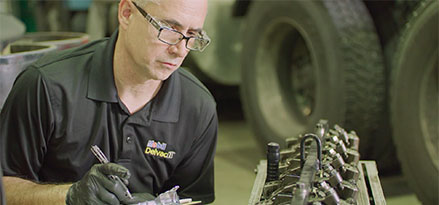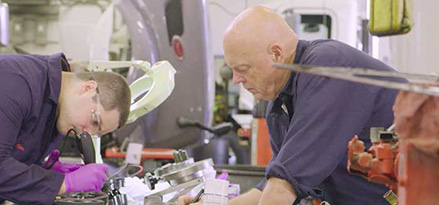A new study from the American Trucking Associations has found that North American fleets are running older equipment much longer, and as a result, fleet maintenance costs are continuing to rise. For smaller fleets that may have their own maintenance facilities for routine PMs and oil changes, but don’t have the educational programs or team resources to complete big repairs in-house, this could cause even more problems, especially as trucking technology increases in complexity.
Repair and maintenance are known to be one of the highest contributors to cost per kilometer. Under the assumption that maintenance costs will continue to rise, agility and creativity will be especially critical for the small- to mid-size fleets to keep trucks on the road. With fewer resources than larger fleet competitors, doing more with less is a necessity. Some services and programs can help save money and ease this burden for fleet maintenance managers. Here are four strategies to help improve fleet performance and operations, even while strapped for resources.
1. Minimize component failures with root cause failure analysis
Fleet maintenance managers should understand the value different services can provide. Standard service fleets should invest in root cause failure analysis, which can help pinpoint the root cause(s) of prior equipment failures and prevent future ones.
Root cause failure analysis utilizes various tools to assess issue areas like shock loads, misalignments, coupling lockups, contamination of lubricants and improper drain intervals. Some of the tools used in this type of analysis include oil and vibration analysis, infrared temperature scanning and bearing failure analysis.
A thorough root cause failure analysis goes beyond just discovering issues and gathering the data. It allows a fleet maintenance manager’s maintenance team to make recommendations that help avoid equipment failures, prolong equipment and component life, and reduce downtime and maintenance costs. These recommendations could include appropriate changes to design, lubrication, operating condition, maintenance, cleanliness and procedures.
2. Get ahead of the challenges with preventative maintenance
With an appropriate preventative maintenance program, fleet maintenance managers will get specific insights to help increase productivity, reduce downtime, improve equipment durability and lower lubricant consumption. While lubrication is vital to a fleet’s success, lubrication and lubrication analysis programs are often overlooked in preventative maintenance programs.
When SEMO Express, a family-owned freight shipping company that operates a 70-truck fleet, wanted to add a lubrication analysis program to their preventative maintenance, they turned to Mobil℠ Lubricant Analysis. Through the full spectrum analysis, SEMO uncovered maintenance issues within their engines. The detailed insights allowed them to take specific corrective action, allowing them to extend their oil drain intervals by 20% and ultimately reduce time spent on maintenance. Less time in the shop, more time on the road.
When deciding which lubrication analysis program best fits the fleet’s needs, fleet maintenance managers should consider three things:
- Are the steps simple?
- Is there actionable, accurate data that provides insight?
- Is a full spectrum analysis provided?
If the answer to all three of these is yes, you’ve found your match.
3. Train and empower your technicians to solve complex maintenance challenges
Beyond equipment analysis and preventative maintenance, fleet maintenance managers should also think about bolstering their technician workforce so they can in-house more of their maintenance and repairs to lower overall operating costs.
To start, fleet maintenance managers could re-examine the benefits package they present to new technicians and find opportunities for improvement. For example, we all know getting the job done requires having the right tools for the job. So, would providing a starter toolset for your technicians help them be more productive?
Encouraging employees to continue learning and sharing knowledge with one another could also go a long way. Fleet maintenance managers can support their technicians by giving them access to all the latest trainings and education they need to solve complex problems. Investing in a technician’s continuing education as well as working with suppliers that have expertise on specific topics, can help increase fleet uptime.
4. Work with suppliers who can provide necessary expertise
Finding the right maintenance supplier depends on your fleet’s specific needs. Are you looking for just a lubricant supplier or a true maintenance supplier?
If you want to maximize your budget, you’ll want a maintenance supplier who can wear more than one hat.
- Is your supplier knowledgeable about your equipment and what it needs to run with more uptime, and for a longer time?
- Do they have close ties with OEMs to keep you updated on the latest information?
- Do they have all the maintenance strategies and tactics to meet their business goals?
- Are they fully apprised of all the newest training and developments so they can pass that knowledge on to fleet technicians?
Whether you are an owner, operator or fleet maintenance manager, the proper maintenance supplier will support your fleet, and keep your vehicles on the road and generating revenue.




